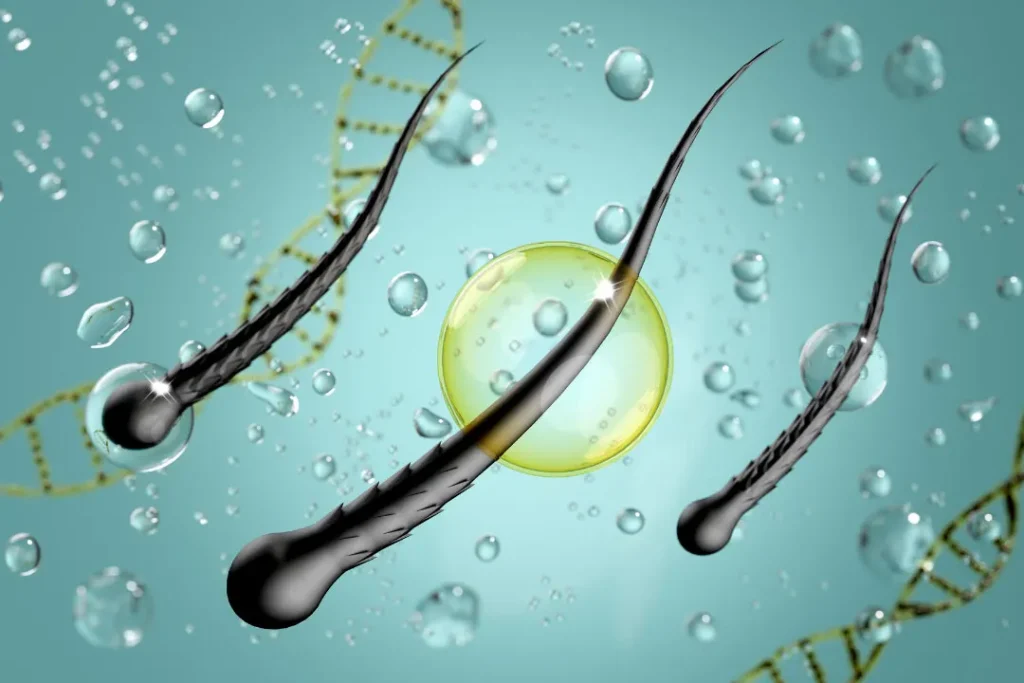Stem cell therapy for hair loss shows promise as a safe and effective way to deliver natural-looking, lasting results. We’ll cover the pros and cons of stem cell therapy as an emerging treatment for hair loss in order to help you make an informed decision.
The human body is an amazing machine, capable of healing itself and regenerating tissue and muscle after injuries and infections. Your body’s stem cells can also repair and restore the growth of hair follicles on your scalp. Instead of getting a toupee to cover those bald patches or undergoing painful surgery, consider stem cell therapy for hair loss and allow your body to create a thick head of hair you’ll be proud of.
You May Also Like:
7 Super Nutrients In Sea Moss For Healthier Skin, Hair, And Scalp
Unlock the Secret to Thicker Hair: How to Unclog Hair Follicles on Your Scalp
Stem Cell Therapy for Hair Loss: Pros and Cons is an original (HerHealthWatch) article.
Hair-raising treatments
Hair loss is common, especially as we age, affecting some 80 million Americans. Maybe that’s why people worldwide spend nearly 5 billion dollars a year trying to restore hair growth. That figure is expected to grow as more hairlines recede. There’s no shortage of treatments for thinning hair, including:
- Medication: The most common topical treatment is Minoxidil (more commonly known by the brand name “Rogaine.”) It’s available without a prescription for both men and women and used to strengthen hair follicles. Keep in mind: You have to use it every day for at least nine months to see any improvement. Several side effects come with using Minoxidil, including scalp itching and burning, swelling, facial hair growth, dizziness, and weight gain. Pills such as Finasteride are also an option. These also come with potential side effects, such as a sudden change in libido.
- Hair transplant: This surgery doesn’t regrow or thicken your hairline: It just rearranges the hair you have by taking plugs from one area of your head and moving them to another. The treatment is permanent and may take several procedures until you see the desired results. It’s usually used as a last resort because it is expensive (from $3,000 up to $15,000) and comes with side effects, including the possibility of infections and scarring.
- Plasma injections: Platelet-rich plasma, or PRP, is produced through a procedure that involves drawing blood and separating the plasma. It’s then injected back into your scalp to reach the bottom of existing hair follicles and encourage new hair growth. These treatments can also be pricey (up to $1,000 a treatment with a minimum of three treatments required.)
- Laser light treatments: Much less invasive than hair transplant surgery, laser light therapy irradiates photons into scalp tissues. These photons are absorbed by weak cells to stimulate the hair follicles. The cost of the treatments varies, depending on the type of device you choose and how many laser lights it contains. A laser light comb may be fairly inexpensive, whereas a cap full of lights could set you back a few thousand dollars.
- Stem cell therapy for hair loss: This innovative treatment focuses on reactivating hair follicles, enabling them to regenerate hair growth. The stem cells can come from bone marrow or blood, but it’s not always wise to use your own stem cells since they may contain the problem materials that led to your hair loss. Using stem cells from plants provides the scalp with nutrients needed to generate hair growth.

Pros and cons of stem cell therapy for hair loss
Stem cell therapy for hair loss is a non-invasive way for people suffering from Alopecia areata or male or female pattern baldness to restore hair growth. Since it doesn’t involve any surgical procedures or drugs, there are few side effects, and because the new hair growth comes from regenerated follicles, the hair looks perfectly natural – unlike plugs that have been redirected during a hair transplant.
Researchers also found stem cell therapy for hair loss was more convenient for test subjects because it doesn’t require constant return visits to a clinic. The cost also varies from a few hundred dollars for topical treatments to $10,000 and more for stem cell therapy for hair loss if it’s combined with a hair transplant or PRP.
Keep in mind: Stem cell therapy for hair loss is still in its early stages, and scientists will continue investigating its benefits. The FDA warns you to be wary of some products claiming to use stem cells, especially if the company doesn’t tell you where those cells come from. While you won’t have to rely on stem cell therapy forever, you may have to wait up to six months to see results. Once you achieve the desired results, you can stop using the treatments.
Stem Cell Therapy for Hair Loss: Pros and Cons is the (HerHealthWatch) report.

Safe and effective stem cell therapy for hair loss
We found several clinics and hair care companies that offer stem cell treatments, but only “More Hair Naturally® 9” offers a stem cell therapy for hair loss that uses plant-based stem cells. It uses mountain ginseng root and bamboo cells along with Adipose-derived stem cells.
Founder and CEO Mahryah Shain notes, “These are not from the controversial embryonic stem cells, but rather donated from fat cells. They are safer and come without the side effects of chemicals like minoxidil.”
More Hair Naturally prides itself on treating the scalp and hair follicles. They also get kudos for their customer service. While you can order their products online or buy them in a salon, they prefer to take phone orders so the staff can answer any questions you may have and direct you on how to use the product.

Keep on growing
Your scalp contains more than 100,000 hair follicles, and each one is capable of producing a single hair. By keeping those follicles alive and constantly replacing any hair that falls out, you can maintain a thick mane for most of your life.
Restoring your hair is more than just a cosmetic concern. A healthy head of hair reduces the risk of sun exposure to those bald spots and decreases your risk of developing skin cancer – finding a non-invasive treatment for balding can save you from scarring or burning. The only thing you have to lose with stem cell therapy for hair loss is the hat you’ve been hiding under.

Further reading for additional reference:
National Library of Medicine: Advances in Stem Cell-Based Therapy for Hair Loss
Better Health Channel: Patterned Hair Loss
Cleveland Clinic: Hair Loss
Important Note: The information contained in this article (Stem Cell Therapy for Hair Loss: Pros and Cons) is for general informational purposes only and should not be construed as health or medical advice, nor is it intended to diagnose, prevent, treat, or cure any disease or health condition. Before embarking on any diet, fitness regimen, or program of nutritional supplementation, it is advisable to consult your healthcare professional in order to determine its safety and probable efficacy in terms of your individual state of health.
Regarding Nutritional Supplements Or Other Non-Prescription Health Products: If any nutritional supplements or other non-prescription health products are mentioned in the foregoing article, any claims or statements made about them have not been evaluated by the U.S. Food and Drug Administration, and such nutritional supplements or other health products are not intended to diagnose, treat, cure, or prevent any disease.



